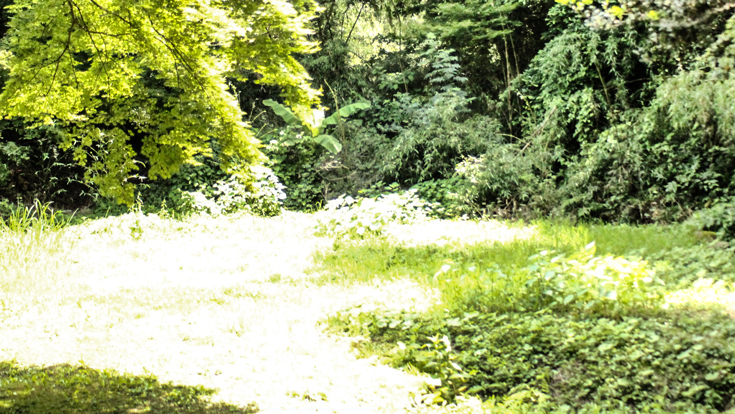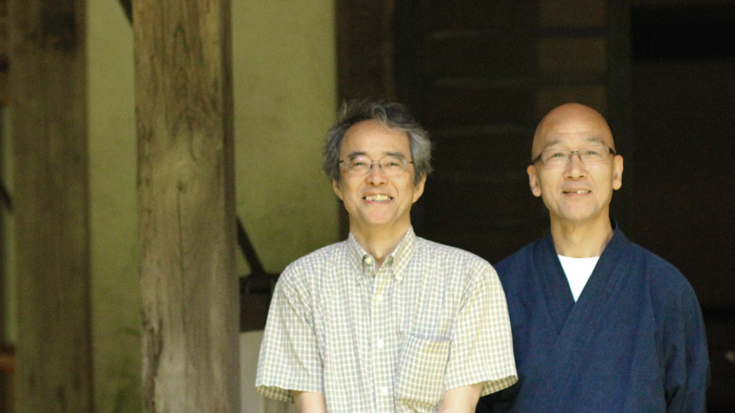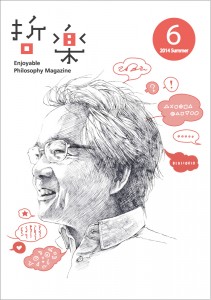

On a sunny Monday on June 23rd 2014, a zazen session was held at the Chizanso in Hayama-cho, Kanagawa Prefecture. The Sobu-Line train from Chiba Station to Zushi Station took two hours. People looked happy in the bright sunshine at the station, and Hitoshi Nagai commented that the air was very elegant. We took a taxi, passing by a residential street, a mountain road, and then under a grand gate with a thatched roof. We crossed a bridge over a small river and continued up a small road listening to the sounds of bush warblers, and arrived at the zazen hall where more than 30 people were already sitting on the floor.
Rev. Issho Fujita, director of Soto Zen Buddhism International, is the manager of the temple, which used to be a resort house. He met Nagai at the Asahi Cultural Center where both of them were teaching and they sometimes visited each other’s classes. Issho soon saw Nagai and beckoned him into the hall. “So many people are here today so don’t exhale hot air from your body too much!” said Issho, which provided a relaxed atmosphere for the mostly local participants. Sitting down on the floor cushions and joining our hands in player, an exercise session started.
Issho instructed zazen in the US for 18 years. He began sessions there with an exercise routine to help relax participants’ mind and body, as most Americans are not in the habit of sitting on the floor. Here at Chizanso, he continues these exercise sessions and also uses many tools to help participants to imagine their body postures. For example, he uses a bellows hose to show how to take a deep breath. It helps participants to imagine where they have to relax by checking both Issho’s body movement and his demonstration with the hose.
After directing our attention toward a tense part in our body, we relaxed it at once with the movement for taking a deep breath. The next routine was moving the pelvis back and forth. We watched a specimen of pelvis bone, and started bending and stretching our backbones by sliding along the floor. After checking where the contact points between the floor and the pelvis bone were, we rolled our pelvises over the floor in a circular motion. We continued the circular movements very slowly, by changing the edge points of circular movements from the navel, papilla, and chin . “Imagine your body as a container filled with water or particles of sand” said Issho.
After the exercise session, zazen began. I opened my eyes a little to check Issho, who went into a silence. He was sitting on the floor like a tree rooted into the ground. Nagai next to me was also like a tree with strong roots and trunk.
While I was struggling to settle into a comfortable position, the voice of Issho rang out through the hall: “Now it’s 15 minutes”. At the Chizanso, the keisaku is not used, but if it was, my shoulder would have been beaten many times.
Issho then told us that the new zazen session will begin, and that we cannot experience the same zazen any more, as he smoothly sat down cross-legged like a Buddha statue.
After the second session, we moved the cushions to another room. Cups of tea and stacks were provided and Issho introduced new participants. Nagai also talked about his philosophy a little bit at Issho’s request. His voice sounded relaxed just as when he lectures at university, and he took questions. It seems like zazen and the human voice are related in some way. Issho’s voice was also stable. His voice, which helped me to continue zazen in silence, controlled many kinds of questions toward Nagai. Everyone’s attention was focused on Issho, who got lots of laughs with his jokes. The laughter made everyone’s shoulders relaxed, their pelvises bone roll down, and their backbones bend in an arch, and then the circle where people were sitting expanded like a balloon for the moment.

Issho’s zazen instruction often makes people laugh. It’s not like shallow laughter, but deep belly laughs where you feel your diaphram vibrating. Even Ngai’s laughed out loud by saying “the mystery was why it was only myself existing in a special way”.
On our way home, Nagai commented on how cheerful people seemed. “Well, everyone is laughing while they are here, but I don’t know how they will be after they go home” replied Issho. The laughter didn’t stop in the car as Issho drove us to Zushi Station.

Photo&Text: Saori Tanaka
 In 31 March 2015, the latest vol.6 has been released from Kindle stores! As a special issue in this volume, the editorial team discussed about a well-known Japanese philosopher, Hitoshi Nagai and the influence of his philosophy on the wide range of pracal fields including psychiatry, Buddhism, and education.
In 31 March 2015, the latest vol.6 has been released from Kindle stores! As a special issue in this volume, the editorial team discussed about a well-known Japanese philosopher, Hitoshi Nagai and the influence of his philosophy on the wide range of pracal fields including psychiatry, Buddhism, and education.
Please check out the nearest Kindle store listed below.
■Japan: Amazon.co.jp ■USA: Amazon.com ■India: Amazon.in
■UK: Amazon.uk ■Germany: Amazon.de ■France: Amazon.fr
この投稿文は次の言語で読めます: Japanese